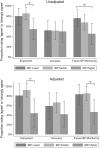User experience of instant blood pressure: exploring reasons for the popularity of an inaccurate mobile health app
- PMID: 31304313
- PMCID: PMC6550164
- DOI: 10.1038/s41746-018-0039-z
User experience of instant blood pressure: exploring reasons for the popularity of an inaccurate mobile health app
Abstract
Instant blood pressure (IBP) is a top-selling yet inaccurate blood pressure (BP)-measuring app that underreports elevated BP. Its iTunes app store user ratings and reviews were generally positive. Whether underreporting of elevated BP improves user experience is unknown. Participants enrolled at five clinics estimated their BP, measured their BP with IBP, then completed a user experience survey. Participants were grouped based on how their IBP BP measurements compared to their estimated BP (IBP Lower, IBP Similar, or IBP Higher). Logistic regressions compared odds of rating "agree" or "strongly agree" on survey questions by group. Most participants enjoyed using the app. In the adjusted model, IBP Higher had significantly lower proportions reporting enjoyment and motivation to check BP in the future than IBP Similar. All three groups were comparable in perceived accuracy of IBP and most participants perceived it to be accurate. However, user enjoyment and likelihood of future BP monitoring were negatively associated with higher-than-expected reported systolic BP. These data suggest reassuring app results from an inaccurate BP-measuring app may have improved user experience, which may have led to more positive user reviews and greater sales. Systematic underreporting of elevated BPs may have been a contributor to the app's success. Further studies are needed to confirm whether falsely reassuring output from other mobile health apps improve user experience and drives uptake.
Keywords: Epidemiology; Hypertension.
Conflict of interest statement
Competing interestsThe authors declare no competing interests.
Figures



Similar articles
-
Trends in user ratings and reviews of a popular yet inaccurate blood pressure-measuring smartphone app.J Am Med Inform Assoc. 2018 Aug 1;25(8):1074-1079. doi: 10.1093/jamia/ocy060. J Am Med Inform Assoc. 2018. PMID: 29878236 Free PMC article.
-
Valuable features in mobile health apps for patients and consumers: content analysis of apps and user ratings.JMIR Mhealth Uhealth. 2015 May 13;3(2):e40. doi: 10.2196/mhealth.4283. JMIR Mhealth Uhealth. 2015. PMID: 25972309 Free PMC article.
-
Pilot Investigation of Blood Pressure Control Using a Mobile App (Cardi.Health): Retrospective Chart Review Study.JMIR Cardio. 2023 Oct 17;7:e48454. doi: 10.2196/48454. JMIR Cardio. 2023. PMID: 37847544 Free PMC article.
-
The Use of Dietary Approaches to Stop Hypertension (DASH) Mobile Apps for Supporting a Healthy Diet and Controlling Hypertension in Adults: Systematic Review.JMIR Cardio. 2022 Nov 2;6(2):e35876. doi: 10.2196/35876. JMIR Cardio. 2022. PMID: 36322108 Free PMC article. Review.
-
Quality and Adoption of COVID-19 Tracing Apps and Recommendations for Development: Systematic Interdisciplinary Review of European Apps.J Med Internet Res. 2021 Jun 2;23(6):e27989. doi: 10.2196/27989. J Med Internet Res. 2021. PMID: 33890867 Free PMC article.
Cited by
-
Patient Acceptance of Prescribed and Fully Reimbursed mHealth Apps in Germany: An UTAUT2-based Online Survey Study.J Med Syst. 2023 Jan 27;47(1):14. doi: 10.1007/s10916-023-01910-x. J Med Syst. 2023. PMID: 36705853 Free PMC article.
-
Evidence of User-Expert Gaps in Health App Ratings and Implications for Practice.Front Digit Health. 2022 Feb 17;4:765993. doi: 10.3389/fdgth.2022.765993. eCollection 2022. Front Digit Health. 2022. PMID: 35252957 Free PMC article.
-
Rating analysis and BERTopic modeling of consumer versus regulated mHealth app reviews in Germany.NPJ Digit Med. 2023 Jun 21;6(1):115. doi: 10.1038/s41746-023-00862-3. NPJ Digit Med. 2023. PMID: 37344556 Free PMC article.
-
The Mobile Health App Trustworthiness Checklist: Usability Assessment.JMIR Mhealth Uhealth. 2020 Jul 21;8(7):e16844. doi: 10.2196/16844. JMIR Mhealth Uhealth. 2020. PMID: 32706733 Free PMC article.
-
The use of photoplethysmography for assessing hypertension.NPJ Digit Med. 2019 Jun 26;2:60. doi: 10.1038/s41746-019-0136-7. eCollection 2019. NPJ Digit Med. 2019. PMID: 31388564 Free PMC article. Review.
References
-
- Aitken M. and Lyle J. Patient adoption of mHealth: Use, Evidence and Remaining Barriers to Mainstream Acceptance. (IMS Institute for Healthcare Informatics, 2015).
-
- Walz, A. & Ganguly, R. The Mobile Marketer’s Guide to App Store Ratings and Reviews, 2015 edition. (Apptentive).
-
- Marketers of Blood Pressure App Settle FTC Charges Regarding Accuracy of App Readings | Federal Trade Commission. Available at: http://www.webcitation.org/6zRGqDyap. (Accessed 2017).
Grants and funding
LinkOut - more resources
Full Text Sources

